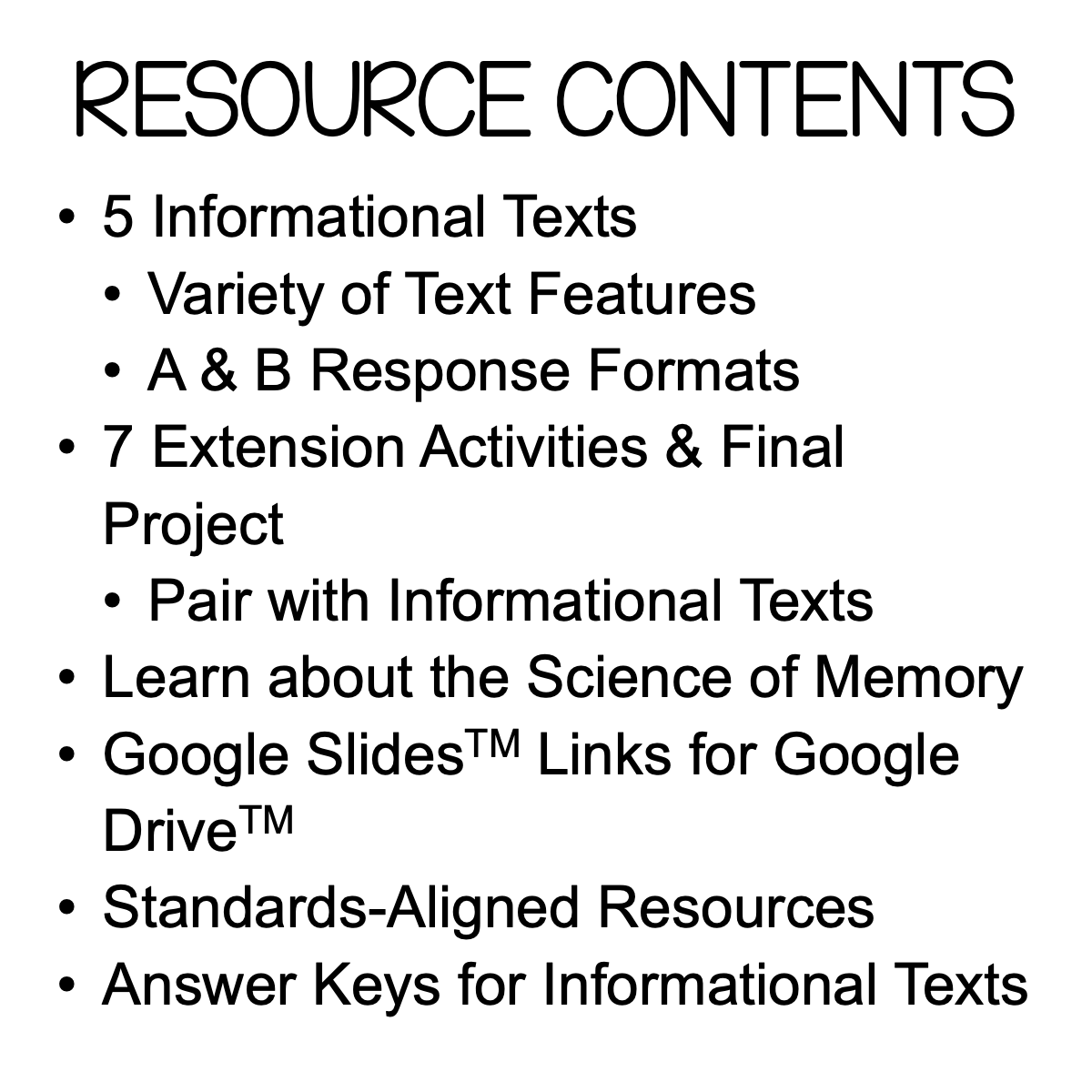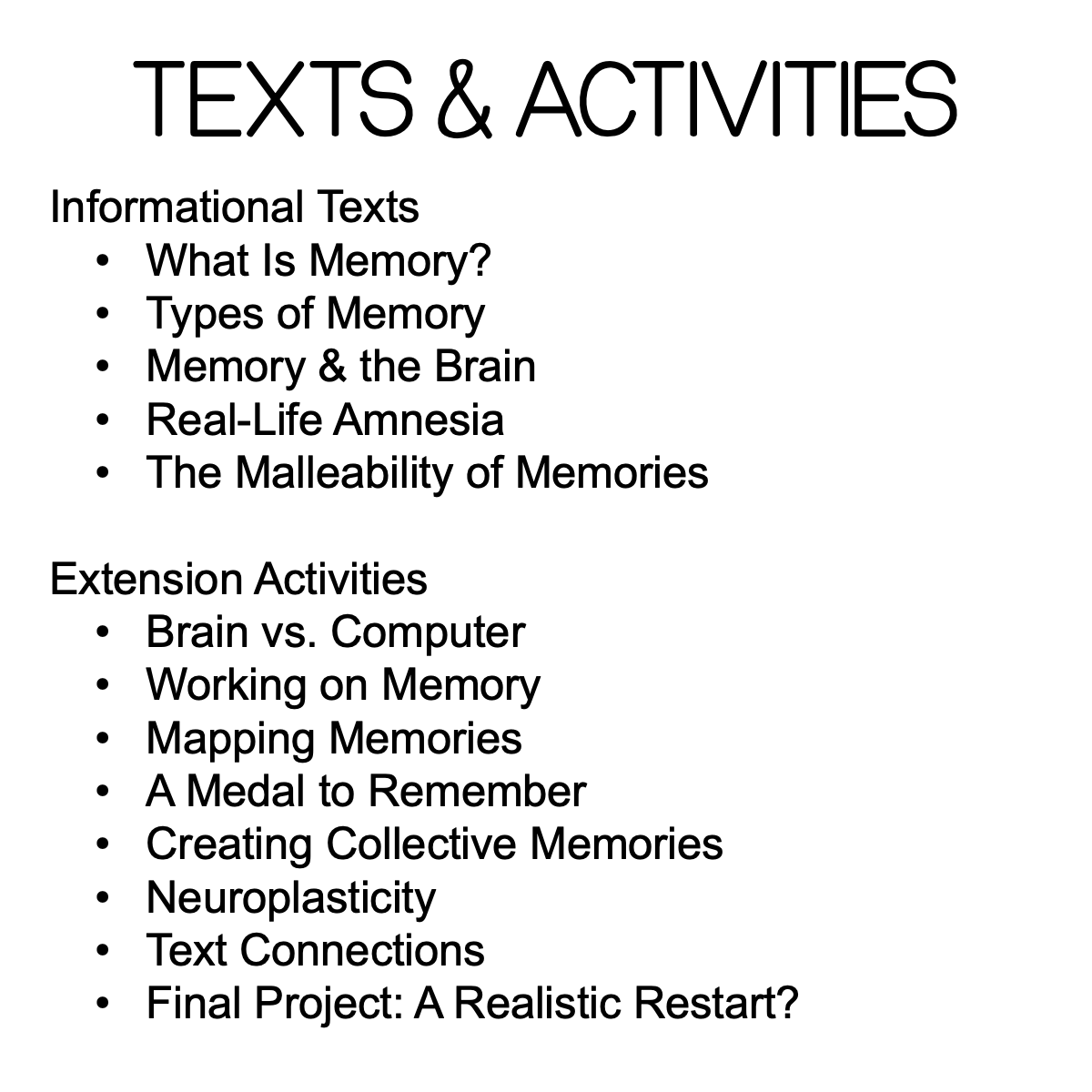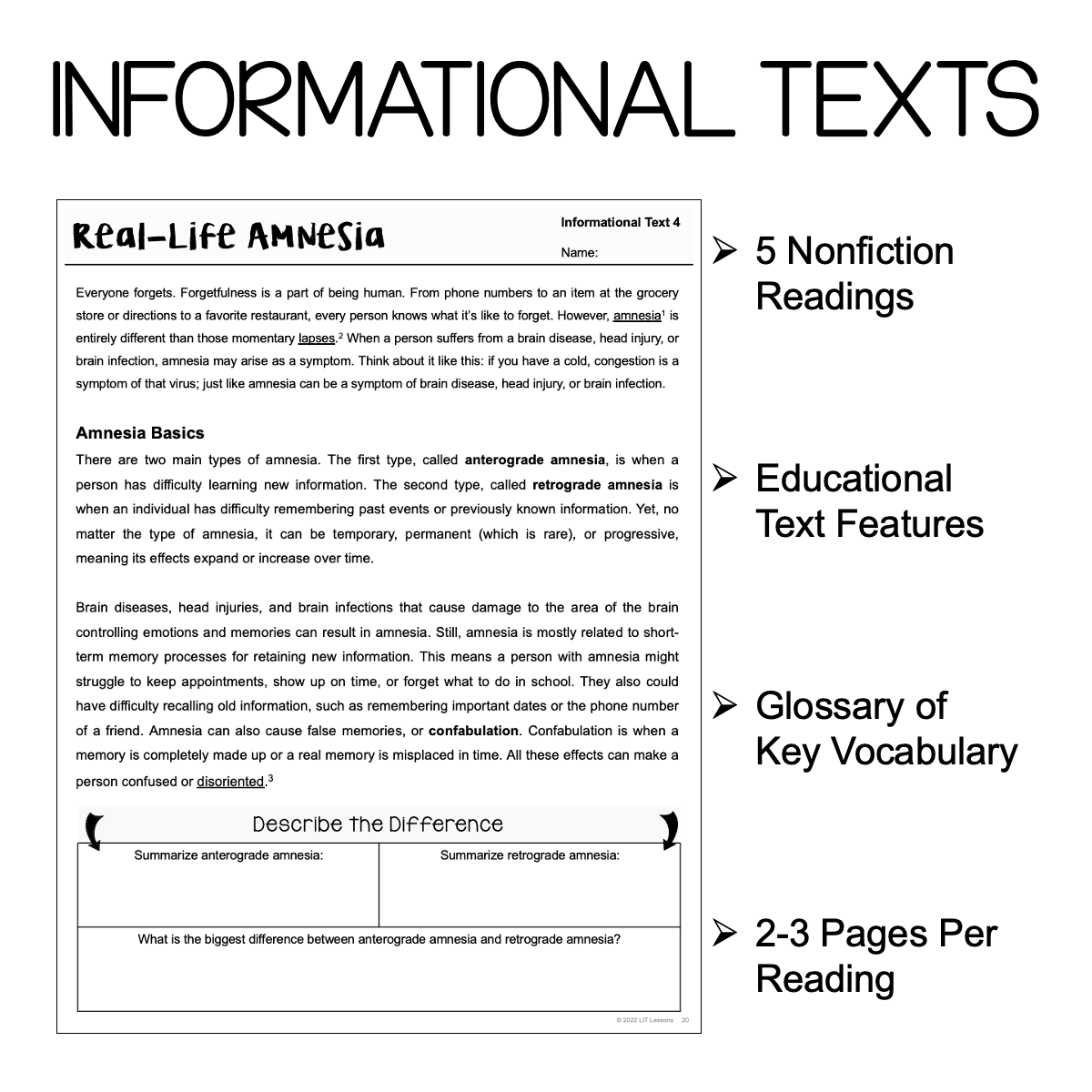Restart Informational Texts & Activities
You can only add to a wishlist if you have an account, please register now.
Create an Account$8
Restart Nonfiction Connections – Snapshot of Included Resources:
- 5 Informational Texts
- Variety of Text Features
- A & B Response Formats
- 7 Extension Activities & Final Project
- Pair with Informational Texts
- Learn about the Science of Memory
- Google Slides™ Links for Google Drive™
- Standards-Aligned Resources
- Answer Keys for Informational Texts
-
What Is Memory?
-
Types of Memory
-
Memory & the Brain
-
Real-Life-Amnesia
-
The Malleability of Memories
-
Brain vs. Computer: Students will apply their learning about the science of memories through this activity. Students will use question stems to conduct research about the computer and the human brain, comparing and contrasting their capabilities. Then, students will take a stance about whether the computer or the human brain is superior.
-
Working on Memory: The “Working on Memory” set of activities engages students in a series of fun brain games. These challenges are a great way to help students hone their working memory skills, exercising this part of working memory in real-time. Feel free to play these games for a class period, use them as bell ringers, or end each class with a working memory challenge. A PowerPoint and PDF of the materials needed to play are included! Please note that image elements (clipart) are not editable.
-
Mapping Memories: This activity has students make connections between the informational text “Memory & the Brain” and their own memories. Students will journal about a chosen memory and identify which part of the memory is stored in which region of the brain.
-
A Medal to Remember: This activity engages students with a presentation to build background knowledge about the Medal of Honor then apply that new knowledge to Restart. The guided notes provide flexibility in how to use the presentation. They can serve as a check for understanding and/or a way to guide students’ learning. Use the handouts to structure a whole class lesson, small group work, individual learning time, or homework. *Please note: Internet access required to complete last part of each presentation.*
-
Creating Collective Memories: Memories can adapt, change, and be altered as they are retrieved time and time again. For the collective memory activity, students will write about, share, and rewrite a memory, taking note of how their peers’ memories may influence personal recollection.
-
Neuroplasticity: This activity involves students listening to a TED Talk about brain plasticity and answering questions about it. It can be completed individually, in small groups, or as a whole class. It is an additional assignment for you to use as you see fit.
-
Text Connections: The text connections resource sees students synthesizing the informational texts and the novel. They will make cross-curricular connections between the texts, activities, and the novel, Restart. Students consider how their new knowledge about memory intersects with Chase’s story.
-
Final Project – A Realistic Restart?: After learning about the science of memories and diving deeper into this fascinating topic, students will connect their learning to the novel Restart. The content of the informational texts illuminates various elements of the novel’s fictional text. The activity will help students synthesize across both. For it, students will select three instances where the connection between the two different types of texts is strongest and analyze these moments for their impact on the novel’s content and message.
- ZIP file (PDFs and Word Docs for Digital Links)
- Non-Editable
- 18.87 MB
- 76 Pages
- Links for Student Pages in Google Slides™
- This downloadable resource supplies one single-teacher license for use in your classroom.
- Photocopying of this product is allowed only for the classroom use of the purchaser.
- Replication of this product, in whole or in part, for commercial sale or broader distribution is strictly prohibited.
- This product also may NOT be shared electronically, digitally, or otherwise in a manner that violates the Terms of Use detailed by LIT Lessons.
- For explicit information on permissions, please see the Terms of Use document included with this resource. Thank you for your cooperation and understanding.
Restart Nonfiction Connections – Snapshot of Included Resources:
- 5 Informational Texts
- Variety of Text Features
- A & B Response Formats
- 7 Extension Activities & Final Project
- Pair with Informational Texts
- Learn about the Science of Memory
- Google Slides™ Links for Google Drive™
- Standards-Aligned Resources
- Answer Keys for Informational Texts
-
What Is Memory?
-
Types of Memory
-
Memory & the Brain
-
Real-Life-Amnesia
-
The Malleability of Memories
-
Brain vs. Computer: Students will apply their learning about the science of memories through this activity. Students will use question stems to conduct research about the computer and the human brain, comparing and contrasting their capabilities. Then, students will take a stance about whether the computer or the human brain is superior.
-
Working on Memory: The “Working on Memory” set of activities engages students in a series of fun brain games. These challenges are a great way to help students hone their working memory skills, exercising this part of working memory in real-time. Feel free to play these games for a class period, use them as bell ringers, or end each class with a working memory challenge. A PowerPoint and PDF of the materials needed to play are included! Please note that image elements (clipart) are not editable.
-
Mapping Memories: This activity has students make connections between the informational text “Memory & the Brain” and their own memories. Students will journal about a chosen memory and identify which part of the memory is stored in which region of the brain.
-
A Medal to Remember: This activity engages students with a presentation to build background knowledge about the Medal of Honor then apply that new knowledge to Restart. The guided notes provide flexibility in how to use the presentation. They can serve as a check for understanding and/or a way to guide students’ learning. Use the handouts to structure a whole class lesson, small group work, individual learning time, or homework. *Please note: Internet access required to complete last part of each presentation.*
-
Creating Collective Memories: Memories can adapt, change, and be altered as they are retrieved time and time again. For the collective memory activity, students will write about, share, and rewrite a memory, taking note of how their peers’ memories may influence personal recollection.
-
Neuroplasticity: This activity involves students listening to a TED Talk about brain plasticity and answering questions about it. It can be completed individually, in small groups, or as a whole class. It is an additional assignment for you to use as you see fit.
-
Text Connections: The text connections resource sees students synthesizing the informational texts and the novel. They will make cross-curricular connections between the texts, activities, and the novel, Restart. Students consider how their new knowledge about memory intersects with Chase’s story.
-
Final Project – A Realistic Restart?: After learning about the science of memories and diving deeper into this fascinating topic, students will connect their learning to the novel Restart. The content of the informational texts illuminates various elements of the novel’s fictional text. The activity will help students synthesize across both. For it, students will select three instances where the connection between the two different types of texts is strongest and analyze these moments for their impact on the novel’s content and message.
- ZIP file (PDFs and Word Docs for Digital Links)
- Non-Editable
- 18.87 MB
- 76 Pages
- Links for Student Pages in Google Slides™
- This downloadable resource supplies one single-teacher license for use in your classroom.
- Photocopying of this product is allowed only for the classroom use of the purchaser.
- Replication of this product, in whole or in part, for commercial sale or broader distribution is strictly prohibited.
- This product also may NOT be shared electronically, digitally, or otherwise in a manner that violates the Terms of Use detailed by LIT Lessons.
- For explicit information on permissions, please see the Terms of Use document included with this resource. Thank you for your cooperation and understanding.



More Restart Resources...
Restart Novel Study
The Restart Novel Study is a comprehensive novel study for teaching Restart by Gordon Korman. This novel study provides unique opportunities to implement an engaging exploration of this popular book. Whether you have taught Restart for years or it is your first time, the Restart Novel Study will provide you with the resources you need to teach a successful and thoughtful unit.
Restart Chapter Questions
The 30 comprehension and literary analysis resources for Restart will give students repeated opportunities to practice essential literacy skills aligned to the Common Core State Standards. For every two chapters, students will have to answer rigorous, text-based questions that assess not only their ability to comprehend but also their ability to analyze key events. There are two sets of questions for each reading: Chapter Questions A (comprehension) and Chapter Questions B (analysis). The twin sets offer different levels of challenge for students to give you options for meeting the needs of all your learners. All 30 assignments include questions that require close reading of the text, which means your students will always be practicing essential skills. With numerous options for implementation, the resource also allows for differentiation and can enable accommodation that will meet the needs of all learners.
The discussion questions provide open-ended prompts to deeply explore the themes and conflicts prominent in Restart. The resources include one prompt for every reading (15) and 12 questions for whole novel analysis. The 15 reading discussion questions are provided in two different formats – graphic organizers and task cards – that will allow flexible implementation. The whole novel discussion questions are provided as task cards. Use the questions for independent work, small group or whole class discussion, reflection, homework, or more.
Restart Close Readings
The 30 close reading lessons (2 for each reading ) explicitly focus on critical Common Core State Standards to develop students’ literacy proficiency. Using Restart as the foundational text for close reading, each lesson focuses on a particular skill, such as setting, conflict, tone, and plot, and provides students an opportunity to develop and demonstrate their ability to perform that skill. Each assignment also requires students to use textual evidence to support their claims. The resources could supply homework, facilitate guided reading groups, or stimulate whole class literacy discussions for each chapter grouping. You can choose the purpose that best suits your students and your classroom.
Restart Assessments
The standards-aligned assessments will help you measure your students’ comprehension of Restart and their ability to apply the literary skills taught throughout the unit. The materials include 15 reading checks, 3 novel quizzes, 1 final differentiated test, and an essay choice board.
Restart Vocabulary
The vocabulary resources will engage students in varied activities to expand their vocabulary found in Restart. The resources include materials to help teach challenging vocabulary words in Restart that will then build your students’ vocabulary. With 4 vocabulary lists of 10 words each and a crossword puzzle, practice assignment, and quiz for each set, the materials provide opportunities for differentiation to suit the needs of the classroom.

Restart Novel Study
The Restart Novel Study is a comprehensive novel study for teaching Restart by Gordon Korman. This novel study provides unique opportunities to implement an engaging exploration of this popular book. Whether you have taught Restart for years or it is your first time, the Restart Novel Study will provide you with the resources you need to teach a successful and thoughtful unit.

Restart Chapter Questions
The 30 comprehension and literary analysis resources for Restart will give students repeated opportunities to practice essential literacy skills aligned to the Common Core State Standards. For every two chapters, students will have to answer rigorous, text-based questions that assess not only their ability to comprehend but also their ability to analyze key events. There are two sets of questions for each reading: Chapter Questions A (comprehension) and Chapter Questions B (analysis). The twin sets offer different levels of challenge for students to give you options for meeting the needs of all your learners. All 30 assignments include questions that require close reading of the text, which means your students will always be practicing essential skills. With numerous options for implementation, the resource also allows for differentiation and can enable accommodation that will meet the needs of all learners.
The discussion questions provide open-ended prompts to deeply explore the themes and conflicts prominent in Restart. The resources include one prompt for every reading (15) and 12 questions for whole novel analysis. The 15 reading discussion questions are provided in two different formats – graphic organizers and task cards – that will allow flexible implementation. The whole novel discussion questions are provided as task cards. Use the questions for independent work, small group or whole class discussion, reflection, homework, or more.

Restart Close Readings
The 30 close reading lessons (2 for each reading ) explicitly focus on critical Common Core State Standards to develop students’ literacy proficiency. Using Restart as the foundational text for close reading, each lesson focuses on a particular skill, such as setting, conflict, tone, and plot, and provides students an opportunity to develop and demonstrate their ability to perform that skill. Each assignment also requires students to use textual evidence to support their claims. The resources could supply homework, facilitate guided reading groups, or stimulate whole class literacy discussions for each chapter grouping. You can choose the purpose that best suits your students and your classroom.

Restart Assessments
The standards-aligned assessments will help you measure your students’ comprehension of Restart and their ability to apply the literary skills taught throughout the unit. The materials include 15 reading checks, 3 novel quizzes, 1 final differentiated test, and an essay choice board.

Restart Vocabulary
The vocabulary resources will engage students in varied activities to expand their vocabulary found in Restart. The resources include materials to help teach challenging vocabulary words in Restart that will then build your students’ vocabulary. With 4 vocabulary lists of 10 words each and a crossword puzzle, practice assignment, and quiz for each set, the materials provide opportunities for differentiation to suit the needs of the classroom.








